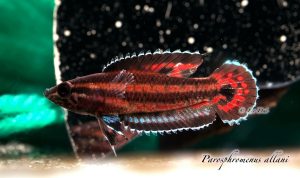
Parosphromenus allani
Brown 1987
First description: Special announcement – two new anabantoid species. Aquarist and Pondkeeper, June edition(1987), 34. (Actually, only the anouncement of a first description, which never followed. Thus it is valid as a first description. Here was also the announcement of P. harveyi, also valid as a first description).
Characteristics: total length max. 4.0 cm, strong physique. Dorsal structure: XI-XIII, 5-6, total 16-19, anal fin: XII-XIII, 8-11, total 21-22. ♂ in breeding plumage with multi-colored unpaired fins, including broader red-brown and narrower blue bands separated by a blackish narrow band, a conspicuous dark spot in the center of the caudal fin, blue-white fin edges without the wide iridescent light bands of other species, but still with very colorful effect; pelvic fins blueish with remarkably short filaments.
The differentiation of the ♀ from other species with rounded tail fin is difficult, they have usually a somewhat more stretched body shape. Colouring of the ♀ is similar but considerably fainter. Forms from the catchment area of Sungai Stunggang are differently coloured (see below), as well as other forms with clearly visible round spot on the dorsal fin (see photo G. Kopic). The status of these forms is not yet clear.
Similar species: low, because the fin colouring, which is in principle also seen in the females, can hardly be confused with other species.
Occurrence / Distribution: North Borneo: Sarawak (Malaysia), e.g. surroundings of Sibu (type locality), but the species was and is apparently quite common in Sarawak. However it is unclear whether the forms found in West Sarawak (river system Stunggang; e.g. near Lundu), which look more or less phenotypically different, are still belonging to this species. Perhaps it is a second Sarawak-species or at least a sub-species (P. sp. Allani cf, also P. spec. Sungai Stunggang or Lundu). It is unclear how other forms are to be judged; see figure. G. Kopic. Brown and Brown 1987 discuss this variability in the Sarawak Museum Journal 37 (p.155-170), Kottelat & Ng 2005 cite it as yet unclear (p. 109).
Threat: very high, especially given the rapid destruction of natural wetland habitats and forests in West Sarawak. Remaining waters are often affected by human activities. Occasionally P. allani can be found in still waters with pond-like structure butut it is unclear if the species can survive in it continuously.
Discovery/First import: Barbara and Allan brown 1986. The discoverers have reported about it in detail in Brown and Brown 1987.
Trade: to our knowledge this species is only known from few private imports. It seems as if it has not appeared in commercial trade to date.
<
Care / Breeding: because of its rarity, this attractive species is hardly known. G. Kopic, who was among the first breeders of this form, recommends soft to very soft water with pH value of 4.5 to 6. For breeding the pH value should be 4.2 to 5. Kopic says P. allani has been very difficult to breed up to now.
Behaviour / Particularities:Head-down courtship.

